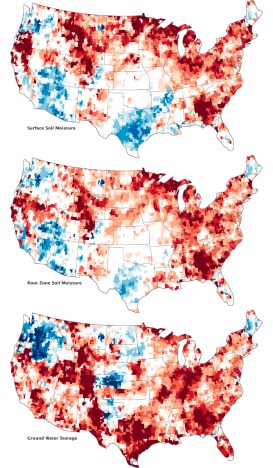
God, we missed you so much, fall. Don’t ever leave* us again. (* Ugh.)
Today is the last day of summer in these United States. It has been a crappy one.
Not, like, your summer. I’m sure your summer was great: ice cream and swimming and lots of time at the arcade, or whatever you do for fun. I mean it’s been crappy for these United States.
For one thing, it was hot. 2012 is on track to easily be the hottest year in America’s recorded history:
Since January, year-to-date temperatures for the continental US have consistently run well above the 20th-century average with each passing month – reaching a maximum of 6 degrees Fahrenheit above average for the period ending March 31, then declining steadily to 4 degrees F above the 20th-century average for the period ending August 31. …
Still, that 4 degrees is at least a full degree higher than January-to-August averages in any of the five warmest years on record.
Yaaaaaay.
For another thing, it has been dry. There was, as we’ve mentioned, a drought.
NASA took it upon itself to figure out how dry. The agency used its Gravity Recovery and Climate Experiment (GRACE) satellites to map water levels at the surface and in the ground. And, voila.
The wetness, or water content, of each layer is compared to the average for mid-September between 1948 and 2009. The darkest red regions represent dry conditions that should occur only 2 percent of the time (about once every 50 years). …
Surface and root moisture recently rebounded in the south central and southwestern states, largely due to Hurricane Isaac and other rainfall in 2012. But even there, the severe droughts of 2011 and 2012 persist below ground in aquifers.
NASA also animated groundwater levels over the past decade. It begins at the tail end of the historic (and under-recognized) drought toward the beginning of last decade. And it ends in 2012, in a whole lot of red.
The way the GRACE satellites work is pretty remarkable.
“GRACE gives you variations in the total water stored on and in the land,” says NASA scientist Matt Rodell in a recent feature story on the Earth Observatory. GRACE does not measure the water directly, but instead detects changes in Earth’s gravity. When the satellites encounter a change in the distribution of Earth’s mass—such as a blanket of fresh snow on California’s Sierra Nevada—they are pulled toward the mountains a tiny bit more than normal. By tracking trends in how the satellite orbits change, researchers can calculate how gravity is changing on Earth. So when groundwater supplies dwindled in the United States in 2011 and 2012, that region of the planet had a little less mass and gravitational pull. The satellite orbits moved a bit in response, allowing GRACE to reveal the change in groundwater storage.
In summary: It’s so dry, you can tell from space. It’s not entirely this summer’s fault, but we’re going to blame it anyway.
So enjoy this fall. Go apple picking! Look at leaves! Hayrides and such! Trick-or-treat! Um, make pies! College football! Do fall things! It’s a great season!
Seriously, make the most of it. Because winter’s going to suck, too.




